A quality stone patio will completely transform the look of your garden. It can boost your home’s curb appeal as well as market value. But laying a stone patio is no small endeavour, so it’s important to avoid costly mistakes.
Your new patio will truly complement your home only if you choose the right stone. Considering how many variables are at play, this can get difficult.
There are a few important considerations you need to be aware of before you make your choice, so let’s get you up to speed.
Manufactured vs Natural Stone
Manufactured stone, also known as veneer stone, is man-made stone that is meant to look like natural stone. Natural stone is of better quality than manufactured stone.
Natural stone is not as susceptible to moss and lichen growth as manufactured stone, and it keeps its good looks for longer. While manufactured stone slabs are more affordable than natural stone slabs, manufacturer stone is usually weaker and thinner.
Natural stone will become slightly darker over time, but many will argue that the patina it acquires is an improvement on its original appearance. The colour of manufactured stone, on the other hand, fades with age.
However, manufactured stone is easier to cut, easier to obtain, and the quality is more predictable. It also comes in a wider variety of colours.
If you are on a tight budget, good-quality veneer could be the better choice. Keep in mind that the cost of labour significantly outweighs the cost of all the materials.
Choosing Your Supplier
If you want to go with natural stone, chances are, the best natural stone for your patio is the one that is sourced locally. Why? Because it is the natural match for your geography. Mother Nature is often the best landscape designer.
Think about Irish Limestone, Pennsylvania Fieldstone, or granite from Cornwall. Stone is one of the factors that give an area distinctiveness.
Try to use the same stone you see in walls, churches, old gardens, and historic buildings around you. If that’s not an option, try to find a type of stone that mimics the geological type and colour of local stone.
On that note, if you are considering buying stone paving slabs for your patio online, consider ordering some samples first. Stones often look different in reality than they do in photos. The best way to make sure the stone you are considering buying will fit in with your own environment is to actually bring it there.
The Size and Shape of Your Patio Paver Stone
One thing is for sure—you want to get the thickest slabs you can afford. The thicker the slabs are, the less chance they will crack or lift after frost.
In order to keep things to scale, choose large slabs if you want to build a large patio. If your garden is small and you plan to build a smaller patio, smaller slabs are a better choice. They will make the area look bigger than it really is.
Cleanly cut slabs offer a more contemporary feel. Cut stone typically comes in rectangular or square shapes. Cut slabs usually have square edges and smooth faces.
If you are going for a more rustic look, flagstone is a great choice. Flagstone is any type of natural stone that comes in irregular and uneven pieces. The unforced and natural look of flagstone paving can give your patio more character.
Best Types of Natural Stone For an Outdoor Patio
Bluestone
There’s a good reason why bluestone has been a staple in patio construction for decades. It brings its surroundings closer to nature while still offering a sense of elegance and luxury.
Don’t let the name deceive you. This type of stone comes in a variety of colours, ranging from green to brown tones. Regardless of the style or cut of bluestone, the smooth blend of colouring is always astounding.
Bluestone is extremely resistant to freeze-thaw cycles, and it has a high non-slip rating. This makes it one of the best choices for poolside patios.
Bluestone comes in all shapes in sizes, from large rectangular slabs to small diamond-shaped pieces. If you want to retain the natural colours and beauty of your bluestone patio, you will have to seal it periodically.
Limestone
Subtly elegant and extremely reliable, limestone has always been a popular choice for patios. It is available in many textural options and shades. It comes in sandblasted, tumbled, or smooth finishes.
Limestone is typically cut to rectangular and square shapes and laid in running bond, herringbone, or basket weave patterns. It can also be a great choice for flagstone paving.
Limestone stays cool in the summer because its light colour deflects heat. However, it does have one drawback. Limestone doesn’t like acidic materials. Falling fruits can easily stain it and chemical cleaners may erode it.
Granite
Granite is a great choice if you want a smooth patio with a high-end finish and neat, straight edges. However, even though it’s a popular choice for sleek and modern-looking patios, it’s also a solid option if you want to go for a more traditional look.
Since it comes in all shapes, sizes, and finishes, it offers a wealth of design opportunities. Available colours include grey, white, pink, deep charcoal, and many more.
Granite is highly durable. It will withstand harsh weather and heavy traffic. It has a long life and is very low-maintenance. You only need to rinse it or pressure wash it from time to time. The only downside of granite is its costly price.
Indian Sandstone
If you are looking for a budget-friendly yet high-quality option for your outdoor patio, Indian sandstone is an excellent choice. Sandstone is naturally slip-resistant and weather-resistant. This makes it a very popular choice for wet climates.
Just like the shades of sand, colours of sandstone range from neutral to vibrant tones. You can choose from subtle beiges to dark browns, from rich reds and bright golds—and anything in between.
Sandstone is easy to maintain and it isn’t afraid of pressure washing. However, it is more prone to dents and scratches than other types of natural stone.




